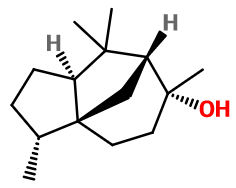
Photo credits: ScenTree SAS
Cedrol
(1S,2R,5S,7R,8R)-2,6,6,8-tetramethyltricyclo[5.3.1.01,5]undecan-8-ol ; Cedar camphor ; (8R)-cedran-8-ol ; Cypress camphor ; (3R-(3alpha,3abeta ; 6alpha,7beta,8aalpha))-octahydro-3,6,8,8-tetramethyl-1H-3a,7-methanoazulen-6-ol

Photo credits: ScenTree SAS
Do you sell any of the raw materials? Would you like to let our users know?
Send an email to fournisseurs@scentree.coto learn about our advertising opportunities.
Do you sell any of the raw materials? Would you like to let our users know?
Send an email to fournisseurs@scentree.coto learn about our advertising opportunities.
General Presentation
-
CAS N° : 77-53-2
-
EINECS number : 201-035-6
-
FEMA number : 4503
-
FLAVIS number : 02.120
-
JECFA number : 2030
-
Appearance : White crystals
-
Density : Donnée indisponible.
-
Volatility : Base
-
Price Range : €€€
Physico-chemical properties
-
Molecular formula : C15H26O
-
Molecular Weight : 222,37 g/mol
-
Log P : 5,29
-
Fusion Point : 87°C
-
Boiling Point : 273°C
-
Detection Threshold : Donnée indisponible.
-
Optical rotation : Donnée indisponible
-
Vapor pressure : Donnée indisponible
-
Refractive Index @20°C : Donnée indisponible
-
Acid Value : Donnée indisponible.
-
Flash Point : 81°C
Uses
Uses in perfumery :
Cedrol is used in woody, leather and masculine notes and perfumes, to give a dry, ashy and sawdust effect.
Year of discovery :
Data not available.
Natural availability :
Cedrol is present in a few cedarwood oils, of various species. All species are called ''cedarwood '' because of their content of Cedrol, even if they are not cedarwoods, botanically speaking. Cedarwood Virginia EO contains between 16 and 25% of Cedrol. Cedarwood Texas EO is the one containing the most Cedrol, with 20% minimum. Eventually, Cedarwood Chinese EO can contain 10 to 20% of Cedrol. Cedarwood Atlas EO, coming from Morocco, does not contain Cedrol.
Isomerism :
Cedrol has a few asymmetric carbons. In general, dextrorotatory Cedrol is used in perfumery, because it is the one present in cedarwood oils. Here, we are talking about this enantiomer. Synthetic Cedrol can be a mix of levorotatory and dextrorotatory Cedrol. Cedrol is also a constitutional isomer of Polysantol® and Javanol®, even if their smell is more reminiscent of sandalwood than cedarwood.
Synthesis precursor :
Cedrol is a precursor to the synthesis of some components used in perfumery. For example, Cedryl acetate is obtained by an esterification reaction involving Acetic Anhydride and Cedrol. Also, a methylation reaction of Cedrol leads to the formation of Cedramber®.
Synthesis route :
Cedrol is generally extracted from cedarwood oils (cf. ''Natural Occurrence ''). Synthesis of Cedrol is not frequent. Extraction of Cedrol leads to a colored and liquid aspect of the molecule, which is not obtained on a pure state. For natural Cedrol, the percentage of Cedrol contained in the sold product has to be mentioned.
Regulations & IFRA
Allergens :
This ingredient does not contain any allergen.
IFRA 51th :
This ingredient is not restricted for the 51th amendment

